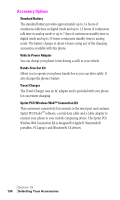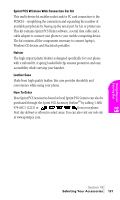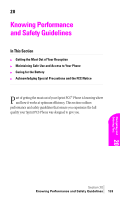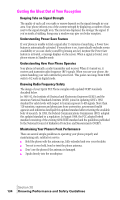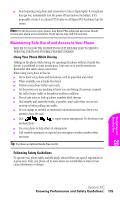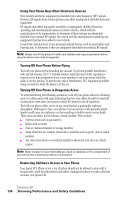Samsung SPH-A460SS User Manual (user Manual) (ver.f3) (English) - Page 135
Maintaining Safe Use of and Access to Your Phone, Using Your Phone While Driving
 |
View all Samsung SPH-A460SS manuals
Add to My Manuals
Save this manual to your list of manuals |
Page 135 highlights
ᮣ Avoid exposing your phone and accessories to rain or liquid spills. If your phone does get wet, immediately turn the power off and remove the battery. If it's inoperable, return it to a Sprint PCS Center or call Sprint PCS Customer Care for service. Note: For the best care of your phone, only Sprint PCS authorized personnel should service your phone and accessories. Faulty service may void the warranty. Maintaining Safe Use of and Access to Your Phone FAILURE TO FOLLOW THE INSTRUCTIONS OUTLINED MAY LEAD TO SERIOUS PERSONAL INJURY AND POSSIBLE PROPERTY DAMAGE Using Your Phone While Driving Talking on the phone while driving (or operating the phone without a hands-free device) is prohibited in some jurisdictions. Laws vary as to specific restrictions. Remember that safety always comes first. When using your phone in the car: ᮣ Get to know your phone and its features, such as speed dial and redial. ᮣ When available, use a hands-free device. ᮣ Position your phone within easy reach. ᮣ Let the person you are speaking to know you are driving; if necessary, suspend the call in heavy traffic or hazardous weather conditions. ᮣ Do not take notes or look up phone numbers while driving. ᮣ Dial sensibly and assess the traffic; if possible, place calls when you are not moving or before pulling into traffic. ᮣ Do not engage in stressful or emotional conversations that may divert your attention from the road. ᮣ Dial wireless phone. to report serious emergencies. It's free from your ᮣ Use your phone to help others in emergencies. ᮣ Call roadside assistance or a special non-emergency wireless number when necessary. Tip: Purchase an optional Hands-Free Car Kit. Following Safety Guidelines To operate your phone safely and efficiently, always follow any special regulations in a given area. Turn your phone off in areas where use is forbidden or when it may cause interference or danger. Navigating and Entering 20 Text Section 20 Knowing Performance and Safety Guidelines 135



